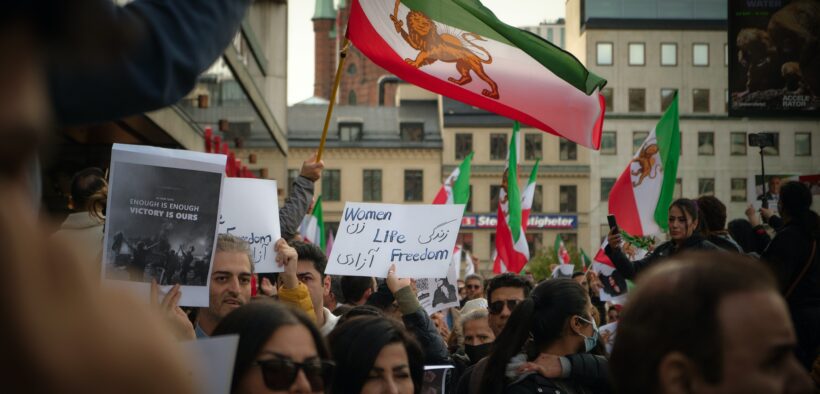Unveiling Iran: A Look Into Iran’s Judicial System
Share

Image Credits: @artinbakhan on Unsplash (Unsplash License)
September 16th, 2022; this marks the day that an innocent woman died in the hands of police while in custody in Iran. Seeing that she was under police custody at the time of her death, people often assume that she was a hardened felon with an extensive criminal record. It was quite the opposite as her crime was an “improperly” worn hijab that would ultimately become the cause of her death. She was arrested by the “Guidance Patrol” in the northwestern Kurdish city of Saqez on September 13th for her improperly worn hijab, a head cover worn by women in the religion of Islam as a symbol of modesty and respect. She was found dead 3 days later, and while officials say she died of a heart attack, according to witnesses she was beaten to death by the police. Her name was Mahsa Amini and she was 22 at the time of her murder.
So, what happened in the course of Iranian’s history that built up to this horrific tragedy? In order to understand the sheer impact and significance of Mahsa Amaini’s horrific murder, one must dive deep into Iranian history and the reason why their government is structured the way it is.
The year was 1978 and the air of change was flowing through Iran. The autocratic monarchy of Mohammad Reza Shah was under fire by opposition forces consisting of Marxists and constitutional liberals complaining about elitism and corruption amongst the Shah Monarchy. Following this fire was the overtake by the mullahs of the country’s Shia hierarchy as they saw this as a chance to rise up while the current government was failing. This takeover by the Shia hierarchy was met with much resistance from the people of Iran as they did not want the country to fall into the hands of the Shia; thus, they began their protests on the streets of Iran, causing the worst work strike the country has ever seen. This movement paralyzed the country and unified the people of Iran as they fought for one common cause: their government. Their purpose was to make sure the Iranian government continued as the people’s government. This resistance was matched with repression from the Iranian government and the mullahs who were trying to secure their position as government officials. Eventually, Mohammad Reza Shah fled into exile in January of 1979 and Ayatollah Ruhollah returned from exile to lead the new Islamic Republic.
What did this shift in power mean for the people in Iran, specifically the women of Iran? The Islamic Regime changed the status for women in Iran, leaving a lasting standard to which the women’s rights agenda has been redefined. To completely see the alteration in the law and position of women in Iran, one must educate themselves on the societal role of women in Iran prior to the revolution.
Though not perfect, in the 1920s, women’s rights started to make appreciable progress towards gender equality and equity. Education became more easily available to the girls of Iran, as it became free for all children. There were also vast changes in women’s suffrage as a result of the Iranian Women Party’s establishment in 1942, which lobbied for advancements in women’s rights, politically and socially. Similarly, much legislation was passed pre-revolution, solidifying the rights and power of women within their society. Some examples include but are not limited to:
- The extension of suffrage to women (1963)
- A raise in minimum age of marriage from 13 to 18
- The ability for women to file for divorce
- The ability for women to fight for child custody under the Family Protection Law
- Freedom of dress, including nullifying the hijab requirement
Women’s rights were on a bright track before the revolution and there was a ray of hope that one day they would reach complete equality. However, this was all undermined by the changes brought upon during the Iranian Revolution.
Post-revolution life for women was a time of regression and suppression. Most changes made before the revolution that were seen as a step forward, were stripped from the women of Iran, and women’s rights were set on a backward track. Strict laws were put into place to restrict the power women had in their society, personal lives, and even their own bodies. Some restrictions and changes include, but are unfortunately not limited to:
- The legal marriage age being lowered to 9 years old (later was increased to 13 because of active lobbyist campaigning)
- Mandatory dress code for women that required all women to wear hijabs regardless of religion or nationality
- Married women could not travel without their husband’s permission
- Women were purged from government positions
- Passing of the Islamic Law of Retribution
- Women were barred from becoming judges
- Lack of policies in place to prevent abuse, protect women, and prosecute domestic violence
In recent years, some of these laws have become relaxed, but most have stayed intact, acting as obstacles for women in their everyday lives. This chain of events led up to the horrific death of Mahsa Amaini, as her death was a result of the change in legislation seen in Iran. The protests and demonstrations seen as a result of her death were messages from the women of Iran for the years of oppression and injustice committed by the Islamic Republic. In the course of the protests, women began unveiling themselves and cutting their hair as a symbol of Amaini’s death, as her crime, in the eyes of the Islamic Republic, was her unveiled hair. The chant “zan, zendegi, azadi” or “women, life, freedom” became the rallying cry of the protestors as they fought for their right to live the life they deserve. These protests have seen their own share of casualties and injuries as 326 people have been killed as a result of them, according to the Norway-based Iran Human Rights NGO. These protests have also reached a worldwide audience as many people from other countries have protested to show their solidarity with the women of Iran. As the grievances and anger of the Iranian women continue in the form of protests, demonstrations, and arrests, lawmakers and the government still show no sign of leniency or reform.


Want to get involved?
Connect with us! Connect with us!